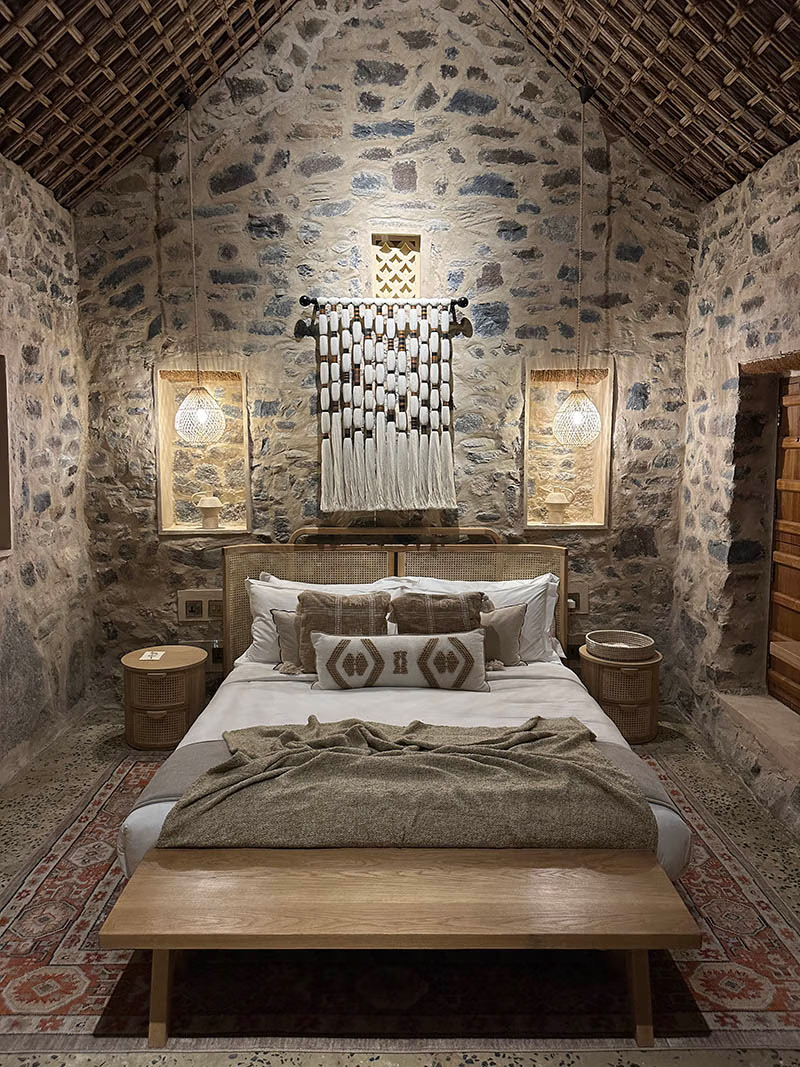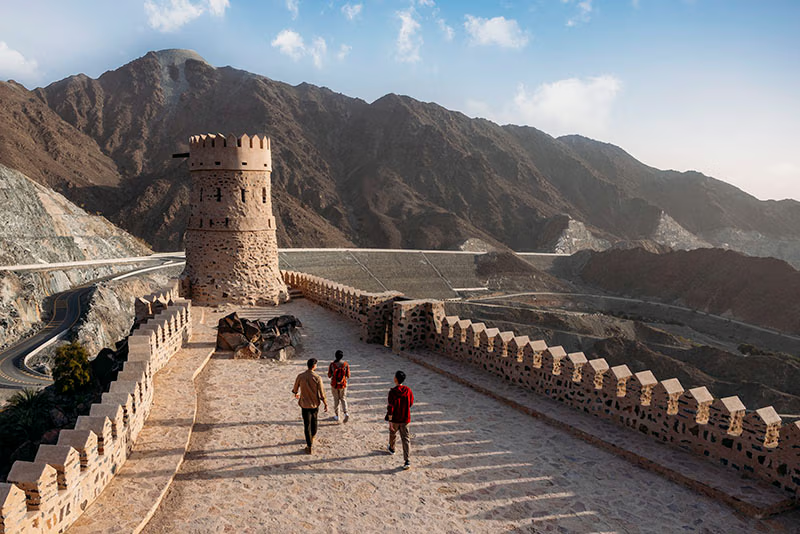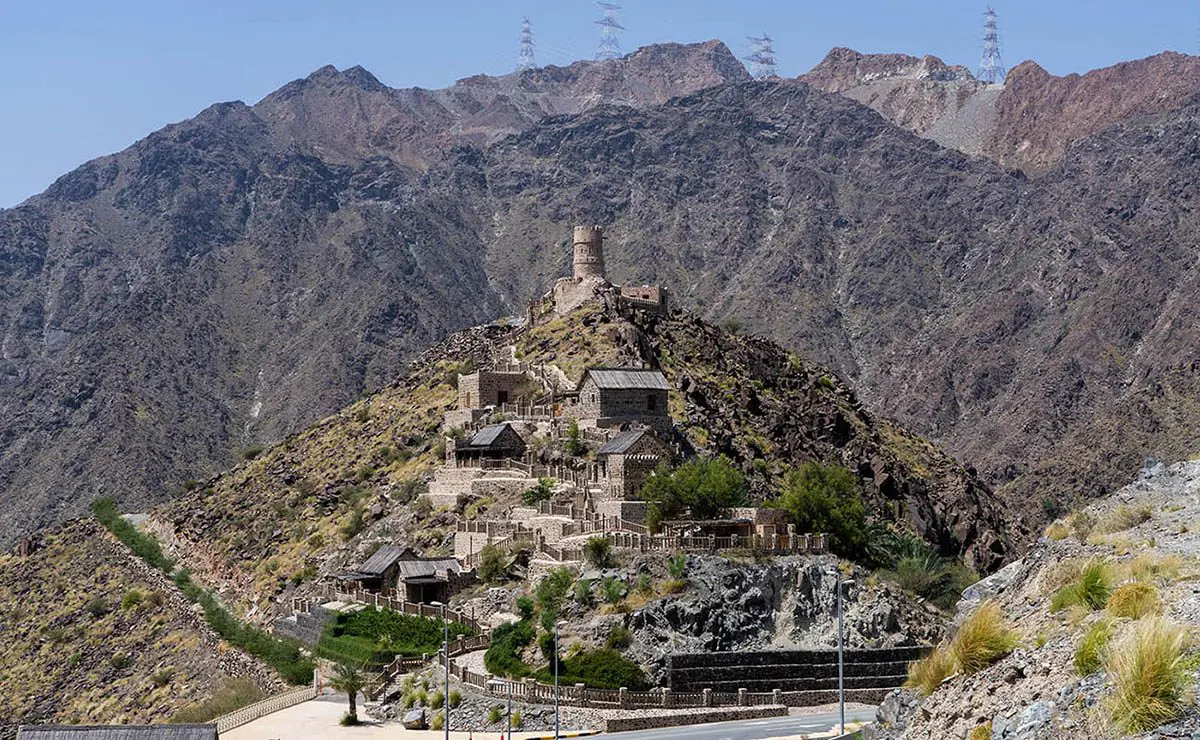A mountain escape
An abandoned village in the mountains above Khorfakkan has been renovated into a unique boutique hotel.
By Nicola Chilton
From an altitude of more than 200 metres, the new heritage hotel Najd Al Meqsar offers sweeping views of Khorfakkan down below. Crowned by the 300-year-old Al Meqsar Fort, the one-time remote village is flanked by the rugged peaks of the Hajar Mountains. The site looks utterly isolated, but it’s a short drive from nearby Al Rafisah Dam and the golden beaches of Khorfakkan.
The latest addition to Shurooq’s Sharjah Collection of hotels that safeguard and celebrate the emirate’s history and culture, Najd Al Meqsar occupies the handsomely restored houses of an abandoned village that dates back a century. The rooms, once homes, are part of a cluster that includes a historical mosque where prayers were held up until the 1960s, a mature ghaf tree, and the fort. Now closed to all but hotel visitors, a stay here feels as if you have your own little village to yourself.
I’m one of the first to check in for a night here in early June, having taken the Sharjah-Khorfakkan Road, a smooth ribbon of tarmac that passes sinuous dunes where camels graze on hardy desert plants. It’s one of the UAE’s most alluring drives, skirting lush date-palm oases before climbing up into jagged grey mountains, hugging curves as the road gets higher, and finally traversing a series of long tunnels before the steep descent to the east coast.


Each room is an individual house constructed from locally hewn stone, and a meticulous restoration of the original village homes. Above, from the 300-year-old Al Meqsar Fort tower there are views across farms, palm plantations, and the Wadi Wishi valley. Top photo, Nicola Chilton; above, courtesy of Sharjah Tourism.
Soon after exiting one of these tunnels, Al Rafisah Dam comes into view, a landmark developed in the 1980s and now popular with families who come to enjoy the kayaks and pedalos. Submerged beneath the waters lie the ruins of Al Hara, an area that was once home to more than 40 houses. The dam is the sign that you’re about to arrive at Najd Al Meqsar, the turret of its fort visible from the road. A sharp and easy-to-miss turn-off leads down to the hotel entrance.
Najd Al Meqsar doesn’t feel like a hotel. Each “room” is a small, individual house constructed from locally hewn stone, a departure from the vernacular coral-stone architecture of the coastal areas and a meticulous restoration of the original village homes.
The interiors are mercifully cool on this scorching day, the sun kept out by traditional wooden shutters and a heavy door. Palm fronds line the ceiling. The interior walls are as handsome as the exterior, their chunks of rough stone in shades of grey, sand and beige echo the colours of the mountains I just drove through. The interior design is minimalist. The few wooden furniture pieces reinforce the earthy palette but offer a softer, organic touchpoint. A white tasselled art piece creates a soft contrast on the wall, a couple of clay vessels sit in lighted alcoves, and a woven carpet on the floor adds a dash of muted colour.

The one-time remote village is flanked by the rugged peaks of the Hajar Mountains. The hotel’s location combines enviable access to both the mountains, with their hiking trails and wadis, and the coast. Photo: Nicola Chilton.
Restored by the AC, I venture out to climb the stone steps that lead to the fort tower with its views across neighbouring farms, palm plantations, and the Wadi Wishi valley. On a clear day you can see the Gulf of Oman from here, but in peak summer humidity it’s hidden in the haze. Back down at the entrance to the hotel, the views from Wishi restaurant are equally striking, seen through floor-to-ceiling windows in the summer and from two outdoor terraces in winter.
Najd Al Meqsar’s location combines enviable access to both the mountains, with their hiking trails and wadis, and the coast. After lunch, I head down to Khorfakkan harbour where the hotel team has arranged for local resident Yousef Al Hammadi to take me on his boat to see the coastline from the water. It is 45 degrees Celsius and even the sea breeze can’t mollify the intensity of the sun. We glide past the huge cranes of the container port that look like mechanical camels with long necks and boxy bodies. As we motor slowly out of the harbour, we stop by the coastguard to show our papers, and they insist on sending us off with Arabic coffee, a plate of fresh dates, cold water, and big smiles. There’s not only a gentleness, but a genuine friendliness to this town.
Later that evening, after a dinner of burrata with date syrup and saffron, and a cauliflower steak topped with pomegranate seeds, walnuts and pistachio at the hotel restaurant, I sit out on my stone terrace where the air has reached a bearable temperature. I’m joined by a little frog, an incongruous visitor in this dry, rocky setting. I assume he must have hopped up from the palm oasis below to snack on the bugs drawn by the lamps I’ve switched on. It’s a suitably unexpected ending to a day spent in a part of the UAE that doesn’t yet receive many visitors from outside the country. They’re missing a trick. This has always been one of my favourite places to visit in the UAE, and with the opening of Najd Al Meqsar, whether overnighting or simply stopping in for lunch, I suspect I’ll find myself here even more often.
Opening aerial image cortesy of Shurooq.




